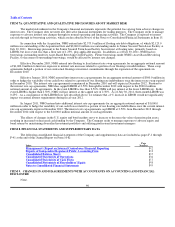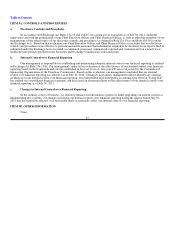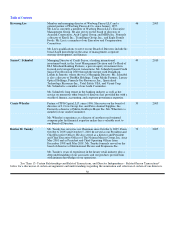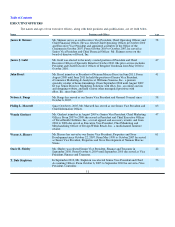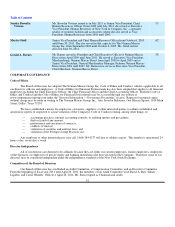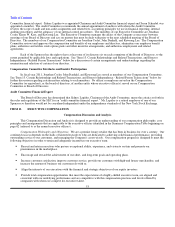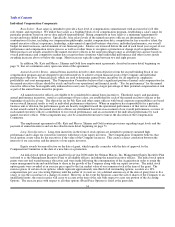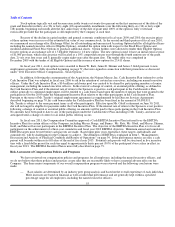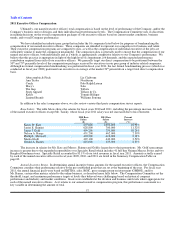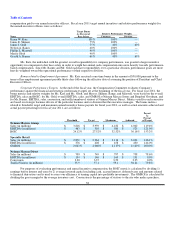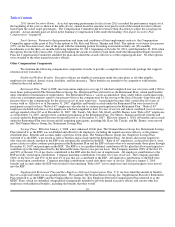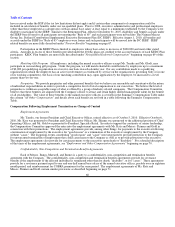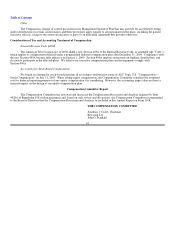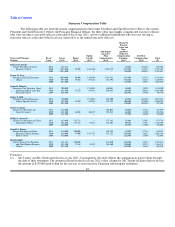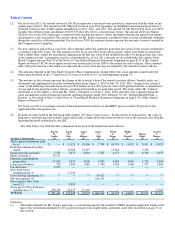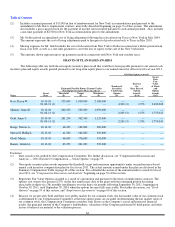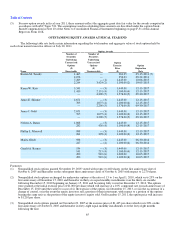Neiman Marcus 2010 Annual Report Download - page 60
Download and view the complete annual report
Please find page 60 of the 2010 Neiman Marcus annual report below. You can navigate through the pages in the report by either clicking on the pages listed below, or by using the keyword search tool below to find specific information within the annual report.
Table of Contents
— Because of our non-public status, long-term incentive awards in the form of stock option grants can be exercised but
the shares must be held until such time as a public market exists for our common stock, thereby aligning the interests of
participants with those of our equity investors.
— Annual incentive bonus awards are based on EBITDA, return on invested capital (ROIC) and inventory turnover,
which are all set at the beginning of each fiscal year based on the achievement of goals that the Compensation
Committee believes will be challenging. Maximum target payouts are capped at a pre-established percentage of base
salary.
The Compensation Committee has discretionary authority to adjust incentive plan payouts and the granting of stock options,
which further reduces any business risk associated with such plan payouts and stock option grants. The Compensation Committee
also monitors compensation policies and programs to determine whether risk management objectives are being met.
Executive Officer Compensation
Process for Evaluating Executive Officer Performance
Role of the Compensation Committee. The Compensation Committee is responsible for determining the compensation of our
named executive officers and for establishing, implementing and monitoring adherence to our executive compensation philosophy.
The Compensation Committee charter authorizes the committee to retain and terminate compensation consultants to provide advice
with respect to compensation of the named executive officers. The Compensation Committee is further authorized to approve the fees
and terms of engagement of any consultant it may retain.
The Compensation Committee considers input from our CEO, our Senior Vice President and Chief Human Resource Officer,
and compensation consultants in making determinations regarding our executive compensation program and the individual
contribution of each of our named executive officers. The CEO does not play a role in decisions affecting her own compensation
other than discussing her individual performance objectives. The CEO's performance and compensation are reviewed and determined
solely by the Compensation Committee.
In developing and reviewing the executive incentive programs, the Compensation Committee considers the business risks
inherent in program designs to ensure that they do not incentivize executives to take unacceptable levels of business risk for the
purpose of increasing their incentive plan awards. The Committee ensures that the plan designs are conservative in this respect and
that the compensation components provide appropriate checks and balances to ensure executive incentives are consistent with the
interests of the Sponsors. The Compensation Committee believes that the mix of compensation components used in the determination
of our named executive officers' total compensation does not encourage our named executive officers to take undesirable risks relating
to the business. For further information, see "Risk Assessment of Compensation Policies and Programs" above.
Role of Management. As part of our annual planning process, the CEO and the Senior Vice President and Chief Human
Resource Officer, with assistance from external consultants, develop and recommend a compensation program for all executive
officers. Based on performance assessments, the CEO and the Senior Vice President and Chief Human Resource Officer attend a
meeting of the Compensation Committee held for the purpose of considering the individual executives' annual compensation and
recommend the base salary and any incentive bonus awards or long-term incentive awards, if applicable, for each of the other
executive officers, including the named executive officers. The CEO and the Senior Vice President and Chief Human Resource
Officer do not participate in the portion of the Compensation Committee meeting during which their own compensation is discussed
and do not provide recommendations with respect to their own compensation packages.
Role of the Compensation Consultants. The Compensation Committee generally retains services of compensation
consultants only for limited purposes. Management retains an independent compensation consultant, Haigh & Company, to provide
comparative market data regarding executive compensation to assist the Compensation Committee in establishing reference points for
the base salary, annual incentive, and long-term incentive components of our compensation package. They also provide information
regarding general market trends in compensation, compensation practices of other retail companies, and regulatory and compliance
developments. The fees paid to Haigh & Company for their services in fiscal year 2011 did not exceed $120,000. Haigh & Company
has no other affiliations with, and provides no other services to, the Company.
56


